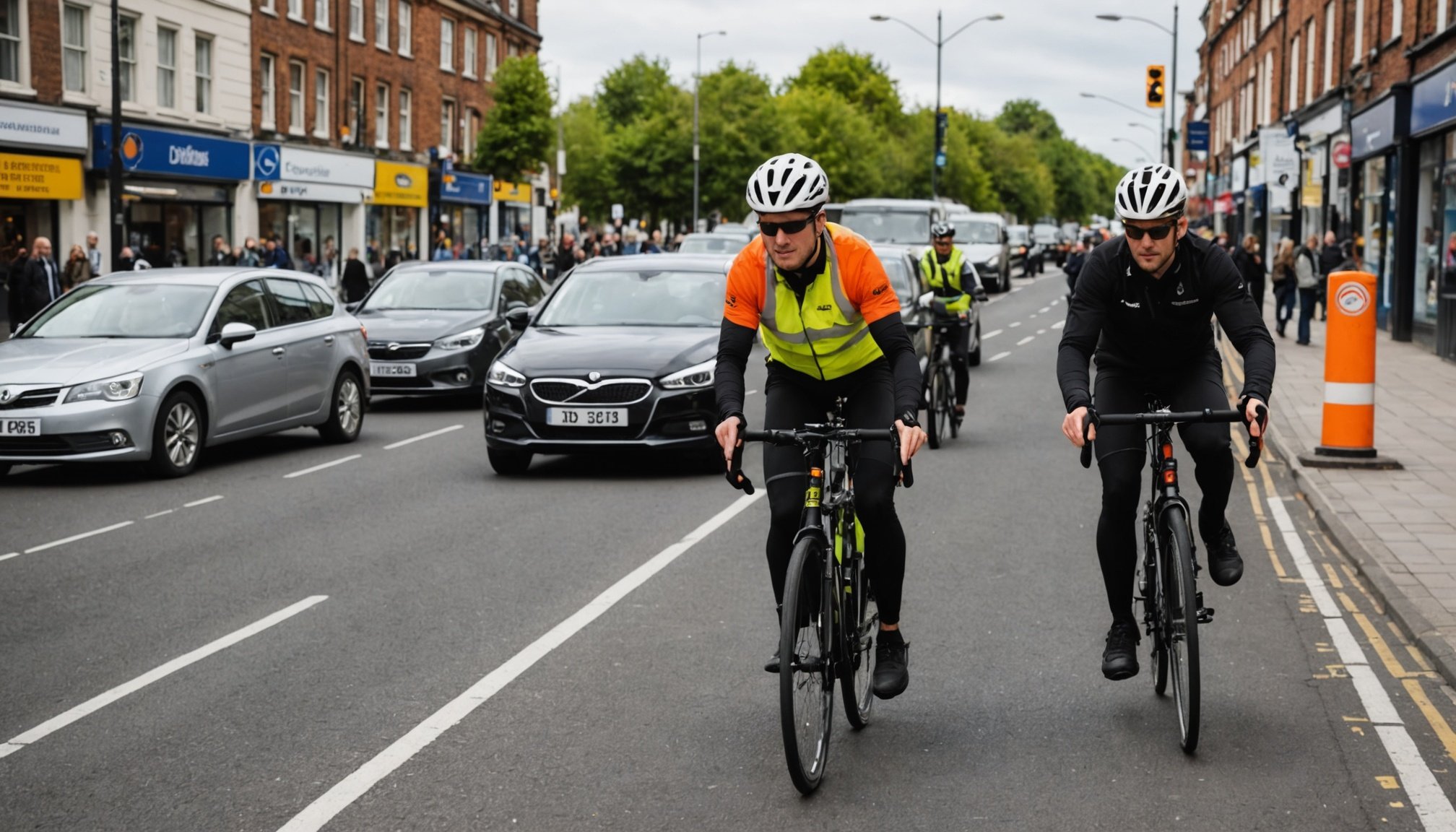Comprehensive Road Safety Guidelines for Cyclists and Drivers
Ensuring road safety is crucial for both cyclists and drivers in the UK. The road safety guidelines demand awareness of shared road rules. For cyclists, this encompasses wearing helmets, using lights, and adhering to traffic signals. Drivers must be vigilant, ensuring that they check blind spots and maintain appropriate distances from cyclists. Recognising hand signals used by cyclists is vital for smooth interaction.
Neglecting road safety protocols can lead to severe consequences. For cyclists, it increases the risk of accidents. For drivers, it can result in legal repercussions that include fines and penalty points. Moreover, it causes potential harm to all road users, highlighting the importance of understanding shared road responsibilities.
Also to read : Essential Qualifications for HGV (Heavy Goods Vehicle) Drivers in the UK: A Comprehensive Guide
Cyclist safety is enhanced when road-users adhere to these guidelines, fostering a safer environment. Ensuring both cyclists and drivers are educated about their respective road rights and responsibilities is essential. Programs that focus on road safety and rules awareness could significantly reduce accident rates. Ultimately, embracing these road safety guidelines cultivates a harmonized coexistence on the roads, benefitting everyone.
Best Practices for Sharing the Road
Promoting safe interactions between cyclists and drivers demands understanding and cooperation on the roads. Core road sharing practices emphasize maintaining awareness of mutual responsibilities. Recognizing and interpreting traffic signals correctly can significantly reduce misunderstandings, thereby enhancing safety for all.
This might interest you : Essential Legal Guidelines for Towing Caravans on UK Roads: What You Need to Know
Understanding Traffic Signals and Signs
Both cyclists and drivers must be familiar with and obey all traffic signals and signs. Cyclists should signal turns and intentions clearly, while drivers need to acknowledge these signals promptly, adapting their driving to accommodate cyclists safely.
Maintaining Safe Distances
Maintaining an appropriate distance is essential for safe road use. Drivers should ensure a minimum of 1.5 meters’ distance when overtaking cyclists, while cyclists should ride predictably, without sudden movements that could surprise drivers. This mutual respect for distance can prevent collisions and misunderstandings.
Communicating on the Road
Clear communication remains a pillar of cyclist and driver interaction. Utilizing hand signals, making eye contact, and using appropriate gestures help both parties understand intentions. These strategies build trust, reduce hesitation, and enable smoother traffic flow. Respecting each other’s space fosters safer road environments for everyone involved.
Relevant Laws for Cyclists and Drivers
Navigating the roads safely in the UK requires a comprehensive understanding of traffic laws, which apply to both cyclists and drivers. For cyclists, adhering to regulations such as wearing helmets, using lights, and following the Highway Code is crucial. Cyclists should be vigilant in open areas, avoid dangerous shortcuts, and use cycling paths wherever possible.
Drivers, on the other hand, have responsibilities too. They must remain aware of cycling regulations and take care to maintain safe distances when overtaking, acknowledging the vulnerability of cyclists. Understanding driver responsibilities, including yielding appropriately and respecting cycling zones, is essential.
Penalties for violating road safety laws in the UK can be substantial. Cyclists and drivers who neglect their legal responsibilities might face fines, penalty points, or even disqualification from driving. For example, aggressive driving or failing to signal correctly can result in hefty penalties. Additionally, cyclists who do not comply with visibility norms or traffic signals could also face penalties.
Being informed and complying with these regulations enhances safety, reduces conflicts, and fosters a respectful co-existence on the roads. Both cyclists and drivers must stay updated with the law to ensure everyone’s well-being.
Statistics on Road Safety in the UK
Understanding road safety statistics is essential for both cyclists and drivers to appreciate the risks and implement preventive measures. Recent data reveals an unsettling trend in accident rates, with a noticeable increase in incidents involving cyclists and drivers. The primary contributors to these unfortunate events are typically poor visibility and inadequate distancing practices.
Analysis of Recent Road Safety Data
An in-depth look into the latest data indicates that the majority of accidents are due to lack of awareness and failure to adapt to changing road conditions. Moreover, intersections and busy urban centres are identified as high-risk areas, highlighting the necessity for heightened vigilance.
Common Causes of Road Accidents
Key factors include driver inattention, failure to yield, and inadequate communication between road users. For cyclists, non-compliance with safety regulations such as neglecting helmets or lights also contributes significantly to accident rates.
Impact of Road Safety Initiatives
Recent safety campaigns have been effective in promoting awareness and reducing incidents, yet there is still room for improvement. By focusing on educational programs and policy enhancements, road users can benefit from a safer commuting environment, thus reducing accident-related fatalities and injuries.
Tips for Safe Urban Biking
Urban environments present unique challenges for cyclists, but with the right preparation and techniques, city cycling can be both safe and enjoyable. Urban biking safety begins with the right gear—helmets and safety equipment like reflective vests and lights are essential. These improve visibility, ensuring drivers can see you, particularly during evening commutes.
When navigating city traffic, mastering several key techniques is crucial. Always position yourself where drivers are likely to see you, and make use of clear hand signals when turning or stopping. Anticipating driver actions and maintaining a steady speed can prevent abrupt stops or swerves, reducing accident risks.
Planning routes before hitting the road allows cyclists to avoid high-traffic zones and hazardous intersections, minimising potential encounters with vehicles. Apps designed for cyclists can offer safer alternatives, guiding you through designated bike paths and less congested areas.
Finally, keeping a constant awareness of your surroundings and adapting to unpredictable elements like pedestrians or sudden vehicle stops enhances cycling safety. Staying alert not only prevents accidents but also ensures a more relaxed and enjoyable urban biking experience.
Visibility and Equipment for Enhanced Safety
Emphasizing cyclist visibility on roads is crucial for preventing accidents, especially in low-light conditions. Safety equipment, like helmets and lights, significantly enhances both rider safety and visibility. Helmets are fundamental in protecting against head injuries, while lights make cyclists more noticeable during evening rides.
Importance of Wearing Helmets and Lights
Helmets provide vital protection in case of falls or collisions. Bright, adjustable lights ensure cyclists are visible to others, reducing accident risks. Front and rear lights, flash modes, and reflective elements are recommended for optimal visibility.
Choosing the Right Clothing and Accessories
Wearing bright, reflective clothing markedly improves visibility. Accessories like reflective vests, ankle and wrist bands, and bike-mounted reflectors amplify your presence on the road, aiding in cyclist safety.
The Role of Technology in Cycling Safety
Advancements in technology offer innovative solutions for road safety gear. Smart helmets, equipped with integrated lights and turn indicators, enhance safety by allowing cyclists to communicate their intentions more clearly with drivers. GPS and cycling apps offer route navigation and real-time traffic updates, benefiting road safety guidelines.
Local Resources for Road Safety Information
Access to comprehensive road safety resources is essential for both cyclists and drivers looking to enhance their knowledge of road safety protocols. Various organisations offer valuable information and support designed to improve cyclist safety and driver safety. These resources emphasise the crucial role of sharing the road responsibly and adhering to established safety guidelines.
Engagement in community programs can significantly benefit road users, providing education on road sharing practices and fostering a culture of safety. Such initiatives often include workshops and seminars focusing on interpreting traffic signals and understanding the importance of maintaining safe distances on the road.
To access local safety guides, interested individuals can connect with cycling clubs and driving associations that regularly update members on the latest cycling regulations and driver responsibilities. These groups serve as platforms for sharing experiences and gaining insights into the best practices for safe road use.
Additionally, numerous online platforms and local government websites provide easy access to safety training and tips, promoting awareness and ensuring cyclists and drivers are informed about their rights and obligations. This collective effort to prioritise road safety ultimately leads to a safer and more harmonious coexistence on the roads.











